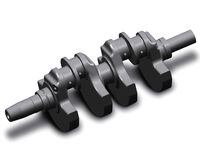VFR1200F Intrigue
When Honda tells us that having the rear cylinders' conrods on the inside of the two forward ones on the new VFR1200F, I can only swallow one of their explanations: That it eliminates the small rocking couple from staggering the rods on the same sides. But this part about "making the rear cylinder bank narrower" has me scratching my head. Unless the center crank journal has to be wider than on an inline-4, wouldn't the cylinder bank's width be determined by the minimum wall thickness between the bores? Am I right or does the center journal actually need to be wider than I think?
John Gregory
Fairview OR
I sent your question off to American Honda, and the response from one of the company's product specialists was that you are on the right track: "The center main bearing does not need to be wider, but there does need to be space for the counterweights, which are wider since there are only four of them where an inline-4 would have eight counterweights." The width of the counterweights determines how far apart the crankshaft's big-end journals are, so mounting the rear bank's connecting rods inboard on each journal can close up the cylinder spacing. On the VFR1200F, there is a substantial savings in width as the unique phasing of the cylinders further separates the two connecting rods on each big-end journal.
Oils Well...
I have a question concerning car oil vs. motorcycle oil and the oil weights. Let's start with the machine in question. It is a 2008 BMW R1200MT. I change the oil and filter every 2000 miles. I was using BMW full-synthetic motorcycle 20W-50 oil from new to 20K miles. Now I have experienced a lay off and money matters much more, so I have been using Mobil 1 full-synthetic car oil 10W-30 for the last two changes. It seems to run better (lighter oil) but I wonder if it is protecting the engine as well or well enough? Remember, BMWs have a dry clutch and the gearbox has its own oil. And how about 90-degree-plus southern California summers and track days at Willow Springs? Is the weight and quality of Mobil 1 oil good enough?
Steve Hill
San Diego CA
The BMW R1200MT model is the Megamoto and the owner's manual for that bike calls for engine oil meeting API (American Petroleum Institute) SF designation or better and ACEA (Association of European Automobile Manufacturers) A2 designation. The Mobil 1 10W-30 automotive synthetic oil meets API SM and ACEA A1 designations. Typically, automobile oils have additives to increase fuel economy and decrease friction and emissions; over the last few years these additives have not agreed with the needs of motorcycle engines that have wet clutches and share crankcase and transmission oil. That is less of an issue on the bikes with separate gearboxes and dry clutches-like the Megamoto-but BMW must be specifying the older API designation for a reason. As for the ACEA, A1 is a low friction/low viscosity designation. A2 has been discontinued but did represent oils with a higher viscosity than the A1 designation; some oils are still labeled as meeting A2, but a good choice for a replacement would be A3, which represents a high performance/high viscosity oil. If you want to use automotive oil in your BMW, I would recommend finding synthetic oil that meets an older API designation and ACEA A2 or A3 rather than using the Mobil 1 10W-30. Mobil 1 has a high-mileage 10W-40 labeled as API SL/SJ and ACEA A3 that would be a good choice.
Got a question? Send a note to Sport Rider, Attention: The Geek, 831 S. Douglas St., El Segundo, CA 90245, or e-mail srmail@sorc.com.



/cloudfront-us-east-1.images.arcpublishing.com/octane/ZN44KZLHD5CHVIY3WZYAGTPGSI.jpg)
/cloudfront-us-east-1.images.arcpublishing.com/octane/5A776WXBY5GAPDYFTTUEUZNIJA.jpg)
/cloudfront-us-east-1.images.arcpublishing.com/octane/NCYHFQ2S3BAT7EC7VDN2ONGRTU.jpg)
/cloudfront-us-east-1.images.arcpublishing.com/octane/XQORS527YFFT3MVI326EOEYJUI.jpg)
/cloudfront-us-east-1.images.arcpublishing.com/octane/TVDPP3TGMZHODFXASIFUM2KD34.jpg)
/cloudfront-us-east-1.images.arcpublishing.com/octane/EWDMR3DDTBBQPI7DQVZCLMRFAE.jpg)
/cloudfront-us-east-1.images.arcpublishing.com/octane/4XHHLVOUKFE3PDSWNSV4JJMGOE.jpg)
/cloudfront-us-east-1.images.arcpublishing.com/octane/5RLI3NQKQJA3LKKCQHRXQFTL6Q.jpg)
/cloudfront-us-east-1.images.arcpublishing.com/octane/3QCYJCI2RNBENIRWAKEOEKHFUM.jpg)
/cloudfront-us-east-1.images.arcpublishing.com/octane/XJFFFMRN6VEZ7CDNAGKWVPC3H4.jpg)
/cloudfront-us-east-1.images.arcpublishing.com/octane/RMC3CHWSHFAUJA2WJ2FVG4NBOA.jpg)
/cloudfront-us-east-1.images.arcpublishing.com/octane/WXEZV4WAYBERFKSRE5M7GQBW7A.jpg)
/cloudfront-us-east-1.images.arcpublishing.com/octane/LO3PZVGICFGJZBNUA2ORUSAUSE.jpg)
/cloudfront-us-east-1.images.arcpublishing.com/octane/UFHLTNOXLVARVLZV32M6ZJZV4Y.jpg)
/cloudfront-us-east-1.images.arcpublishing.com/octane/CTSWNU7SNNCC3LWB2KATYZ5AXY.jpg)
/cloudfront-us-east-1.images.arcpublishing.com/octane/72EPJVNA2VGVXJ2BVDFFLN67KQ.jpg)
/cloudfront-us-east-1.images.arcpublishing.com/octane/A7C4GNXEHNHC3LL6RETG6MIPPY.jpg)
/cloudfront-us-east-1.images.arcpublishing.com/octane/Q4KZ7ACKF5BVTE56LMG7RPJCEM.jpg)
/cloudfront-us-east-1.images.arcpublishing.com/octane/RQ2CXG6ATJBUZGUR7NP35C3VBE.jpg)
/cloudfront-us-east-1.images.arcpublishing.com/octane/MWSEWNFALBBJHOQGZTUUPVOQOU.jpg)
/cloudfront-us-east-1.images.arcpublishing.com/octane/LTPXG4ZHCVFNDNILFQ6PN6YUKI.jpg)
/cloudfront-us-east-1.images.arcpublishing.com/octane/EAEWHFARGVGHFH4N4BDOSNBJSU.jpg)
/cloudfront-us-east-1.images.arcpublishing.com/octane/AZ7H35TQSZDKZCVM4S6CHERQEU.jpg)
/cloudfront-us-east-1.images.arcpublishing.com/octane/GYMIU7SMN5CWHP6QLFR6MVKEBU.jpg)